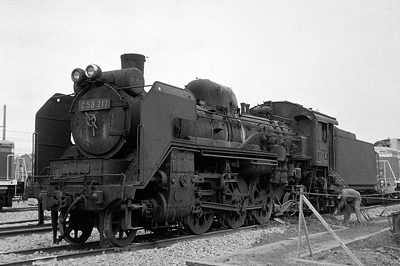
C58 No. 217
At Sakura depot, during 1969.
Japanese
|
1938 - 1975 A middle-sized Tender-Engine for mid-range passenger and freight trains. |

C58 No. 217 At Sakura depot, during 1969. |
|
The C58 meets the needs for branch line passengers, freights, in both plains and mountain regions.
It is an all-around medium sized standard engine.
Originally, the C58 was designed as a modern standard engine which combined the good performance of the passenger model 8620's high-speed and the freight model 9600's high-power. C58 was the first to adopt the 1,520 mm driving wheel diameter as a domestic model in order to shorten its length. Consequently, the main rod was shortened, however, vibration at high speed later became a problem. And tractive effort was less than the class 9600 because of deficient adhesion weight by the 1,520 mm C type driver. Accordingly, since the power of the C58 was not sufficient for freight train replacement, it was mainly used as a replacement for passenger class 8620. The first C58 was manufactured at the Kisha Seizo Co. it's manufactured number was 1578 during August 1938, and was active mainly in the Kanto area. Later she was moved to Hokkaido. During October 1972, she was preserved at Umekoji museum. 382 C58s were manufactured from 1938 during the pre-WW2 period, and 45 were made after WW2, a total of 427 (*) were manufactured. (* JGR - 427, Private R.- 4 Total - 431) During 1941-1942, ten C58s were ordered from Karafuto Railway. (currently South-Sakhalin in Russian territory.) At that time, the railway oversight organization was an independent organ of the Japanese government railway. Karafuto Railway's C58s were named class C51 No. 1 - 10. During 1943, Karafuto Railway was integrated with the Japanese government railway and they were renumbered with the ensuing JGR C58's No. 369 - 378. Karafuto Railway added four more C58s, they were named C58 No.379 -382 during 1943. Fourteen Karafuto C58s were lost by the wars end. A total of 25 engines were converted to narrow gauge (1067mm 3ft-6in -> 1000mm), and they were transferred to South-East Asia. After WW2, four (No.52, 54, 130 and 136) engines were found on the Thailand Railway, and they worked as Thailand Railway's No.761 - 764. 386 C58s still saw service almost all over Japanese local lines with the exception of 41, 25 were moved overseas and 14 to Karafuto Railway, and 2 were war-damaged (No.238 and 343). The new model (tentative class name C63) was the planned replacement for the old classes during 1955. The design was completed, but, not manufactured. The C63's specifications were the same as the improved C58. Finally, the last C58s survived on Japan's northern island Hokkaido and on the south island of Kyushu. South Kyushu's last C58s were Shibushi depot's No.112, 275 and 277. They saw service up to January 1975 on the Shibushi line. Northern Hokkaido's last eight C58s were Kitami depot's No.33, 98, 119, 139, 390, 395 and 418. They saw service between the Kitami and Abashiri section on the Sekihoku line until July 1975. |
| Primary ran line in last 10 years |
Sekihoku, Senmo, Nemuro, Matumae, Hatinohe, Rikuu-Tou, Sobu, Narita, Hatiko, Nanao, Futamata, Obama, Nara, Tuyama, Geibi, Yosan and Shibushi line etc ...
| Last line/depot and year |
Shibushi, Sekihoku line / Shibushi,
Kitami depot Jul.1975
| Restored engine (2017) |
2 (No.239, 363)
| Preserved engine (2017) |
52
| |
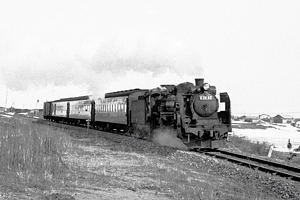
|
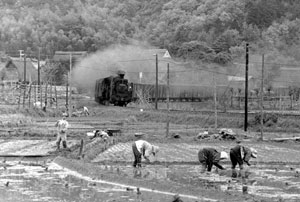
| ||||||||||||
|
C58_82 at Hamakoshimizu on the Senmo line Northern Hokkaido. Mar 1970. |
C58_223 at Wakasa-Hongo, Obama line May 1971
| 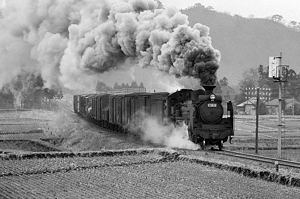
| 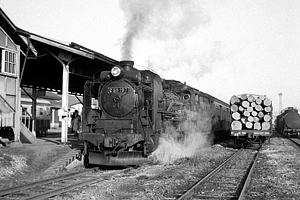
C58_6 beginning a grade climb | on the Rikuu-Tou line at Nakayama-daira. Mar 1972.
Express "Taisetu" at Bihoro station. | C58_197 Mar 1970
| 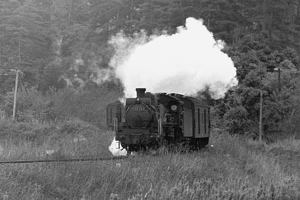
| 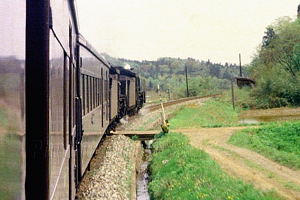
C58_278 at Wakasa-Wada, Obama line | during Jun 1970
Taken from a double-headed C58 pulling train. | Obama line May 1971
| 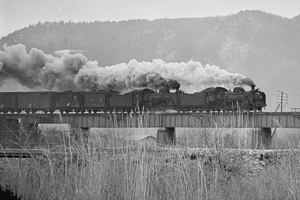
| 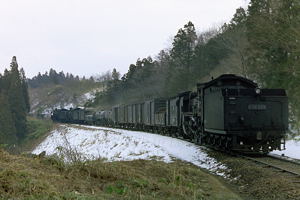
Double-headed C58 under full steam run | during March's last snow among Naruko's mountain sections in northern Honshu. Higashi-Naruko, East-Rikuu line Mar 1968.
Two head (C58_365 + No.?) and one rear (C58_228), | triple C58 pull and pushing a freight train on the East-Rikuu line. 1971 |
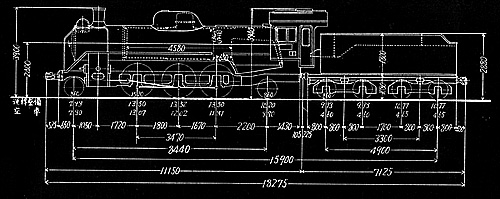
| Configuration | 2-6-2 | Dimensions Length (mm) | 18275 (18325) |
| Engine Weight (Operating tons) | 58.7 (58.9) | Driver size (mm diameter) | 1520 |
| Boiler pressure (Kg/cm2) | 16.0 | Max Tractive effort (tons) | 10.1 (10.3) |
| Driver Max Power (PS) | 880 | Max Speed (km/h) | 85 |
| Manufactured years | 1938-1943,1946,47 | Total production | 427 |
| Number of moved out to other countries in WW2. | 39 | Gauge | 3ft 6in (1067mm) |
Introduction |
Go to Top |